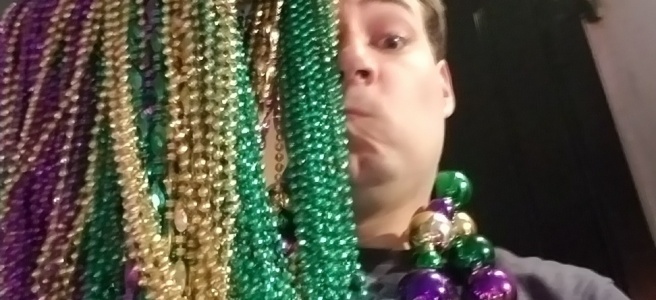When most people think of Mardi Gras, they think of the craziness that happens on Bourbon St. There is way more involved with Mardi Gras in New Orleans than that. The first Mardi Gras in New Orleans happened on March 2,1699. The parades in New Orleans are set up and put on by groups called Krewes. The first krewe, Comus, was formed in 1856. Mardi Gras became a state holiday in 1875. 1972 was the last year that any major parade went thru the French Quarter, most of them skirt around the edge up and down Canal St. now. The traditional colors are Mardi Gras are green, gold, and purple. Green for power, gold for faith, and purple for justice. The colors were used in the first parade of the Rex krewe in 1872. There are now about 77 krewes in New Orleans that hold parades throughout the Carnival season. The parades have a lot of different throws of beads, stuffed animals, and doubloons that are considered collectors items.
Bourbon St. is where most of the tourists head to during Mardi Gras. Bourbon St. was just a residential area up until the 1880’s, when the first red light district popped up along Basin St. By 1950, there were at least 50 different burlesque, striptease, and exotic establishments. In 1962, a new district attorney Jim Garrison started to clean up Bourbon St., shutting down a lot of establishments that were involved in prostitution and overcharging alcohol. When Mayor Moon Landrieu was elected in 1970, he turned Bourbon St. into a pedestrian mall and “Disneyfied” it.
Bourbon St. is where you want to go if you want your “Girls Gone Wild” version of Mardi Gras. There are a lot of people offering beads and there are also a lot of people with cameras and phones out for those that do decide to partake in the exchange. You also have to watch your step walking around on the street. There are potholes up and down Bourbon St. that do get filled up with various liquids, and you do not want to step in it and have leave your shoes/socks/pants behind in New Orleans! During the day, it is pretty easy to move up and down Bourbon St., but at night, it can be very difficult with the crowds of people. I recommend traveling up a side street like Royal or Dauphine to get to where you really want to be on Bourbon St. Being on a balcony on Bourbon St. is amazing anytime of year, more so over the Mardi Gras season. Most of these balconies are rented out to private parties, but you might be able to pay a small cover charge to get up on one if you really wanted to!
I have never stayed up late enough to see it, but the traditional end to the Mardi Gras season in New Orleans is a mounted squad of New Orleans police officer push everyone out of upper Bourbon St. where most of the tourists hang out at. This happens at the stroke of Midnight of Ash Wednesday. I highly recommend everyone at least experience Carnival season in New Orleans at least once in your lives. It is a huge party you really have to see it to believe it!



